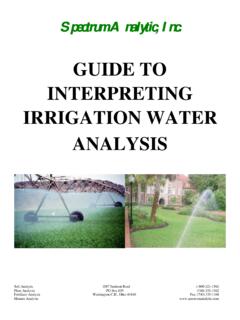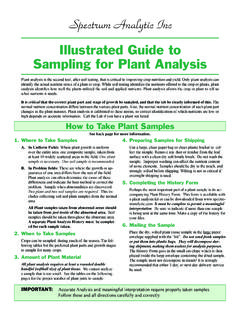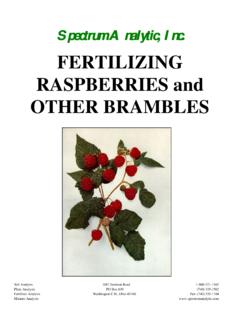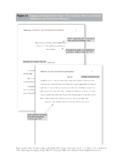Transcription of FERTILIZING - Spectrum Analytic
1 Spectrum Analytic Inc. Soil Analysis 1087 Jamison Road 1-800-321-1562 Plant Analysis PO Box 639 (740) 335-1562 Fertilizer Analysis Washington , Ohio 43160 Fax: (740) 335-1104 Manure Analysis FERTILIZING BLUEBERRIES 2 Table of Contents Introduction .. pg 3 Nutrient Utilization in Blueberries .. pg 4 Site/soil Selection .. pg 5 Site pg 5 Soil pH .. pg 6 Manure on pg 8 General Comments on pg 8 Nitrogen .. pg 9 pg 11 Potassium .. pg 16 Calcium .. pg 19 Magnesium.
2 Pg 23 Sulfur .. pg 26 pg 29 Boron .. pg 30 Copper .. pg 33 Manganese .. pg 35 Zinc .. pg 37 Iron .. pg 39 pg 41 Chloride .. pg 43 Other Elements .. pg 45 References .. pg 46 3 Introduction All blueberries belong to the genus Vaccinium. This genus also includes cranberries, lingonberries, and bilberries. Blueberries are native to North America only. There are four species of blueberries commonly cultivated: Highbush (Vaccinium corymbosum), Lowbush (Vaccinium myrtilloides and Vaccinium angustifolium), and Rabbiteye (Vaccinium ashei).
3 The most obvious differences between the three types of blueberries are in their growth habit. Lowbush varieties typically grow to a height of from 1 to 2 feet. Highbush varieties will grow to a height of from 6 to 13 feet, but are normally pruned to a height between 6 and 8 feet. Rabbiteye varieties can also grow quite tall, but are typically pruned to less than 10 feet tall. Michigan State University reports that no crop will be harvested the first two years after planting. Properly managed plantings will yield 400 to 800 lb/acre the third season and 1,400 to 2,000 lb by the fourth year.
4 Full crops of 4,000 to 6,000 lb/acre are generally harvested after six to eight years, although mature plantings can yield in excess of 10,000 lb/acre under optimal conditions. Well-maintained blueberry bushes remain productive for at least 15 to 20 years. Blueberry Rankings by State, 2003 State Rank HarvestedAcres State Rank 1/Yield per Acre (Lb/a) Michigan 1 15,400 Oregon 1 8,330 New Jersey 2 7,500 Washington 2 6,000 Georgia 3 4,600 N.
5 Carolina 3 5,360 N. Carolina 4 4,200 New Jersey 4 5,330 Oregon 5 3,000 Indiana 5 4,170 Washington 6 2,200 Michigan 6 3,900 Florida 7 1,900 Georgia 7 3,700 New York 8 700 New York 8 2,860 Indiana 9 600 Arkansas 9 2,820 Arkansas 10 550 Florida 10 1,840 Alabama 11 320 Alabama 11 1,410 1/ Yields are based on utilized production.
6 Blueberries have fine, fibrous roots that do not develop root-hairs. All types form symbiotic relationships with mycorrhizal fungi, which aid root functions. Lowbush varieties have most of their roots in the top 3 to 10 inches of soil, while the roots of highbush and rabbiteye varieties reach depths of 30 inches. Highbush blueberries are the most commercially important, both in cultivated acreage, yield per acre and total tonnage harvested annually. Lowbush blueberries are primarily grown in New England and the Maritime Provinces of Canada.
7 Lowbush blueberry fields are typically wild in origin, rather than having been planted. They are found on shallow, rocky soils typical of their natural range. Lowbush varieties are thought of as being more cold-tolerant, but this might be due to their short height and the natural protection of snow cover that this often affords. Rabbiteye varieties are primarily grown in the Southeast They tend to be less cold-tolerant and require less chilling to flower successfully. Highbush blueberries are not very drought tolerant and do best in acid soils with high organic matter, lowbush and rabbiteye varieties require the same acid soils, but are more drought-tolerant and may be less demanding as to soil organic matter.
8 However they will benefit from the same soil conditions as highbush varieties. In recent years 4breeders have developed some hybrids of highbush and lowbush varieties that combine some of the better traits of each species. If a new planting is contemplated, the site should be chosen carefully. The soil should have a naturally acid pH, high organic matter, and be near a ready source of irrigation water. Unless otherwise noted, this paper will focus on highbush blueberries. NUTRIENT CONTENT OF BLUEBERRY FRUIT (USDA)Pounds of Nutrient per Yield Nutrient Utilization in Blueberries Yield In other papers focused on FERTILIZING a particular crop, we have tried to list the nutrient uptake and removal for as many nutrients as possible.
9 This has proved to be difficult for blueberries due to the limited amount of available data. The USDA has published the following nutrient removal data for blueberries. per Acre N P2O5K2O 100 lb 1000 lb 6,000 lb 12,000 lb We were unable to find data for the nutrients contained in the leaves and woody portions of the plant.
10 However, we would logically expect that these values would represent a significant portion of the total uptake of a mature plant. For example with apples and grapes, two crops where there is some data on the nutrient content of the leaves and wood, we can see a rough comparison of nutrient removal vs. the nutrients contained in the woody portions and leaves. It isn t unusual to find that, when compared to the fruit removal values, the wood and leaves contains about 200% of the N, 100% of the P2O5, and 125% of the K20.
















